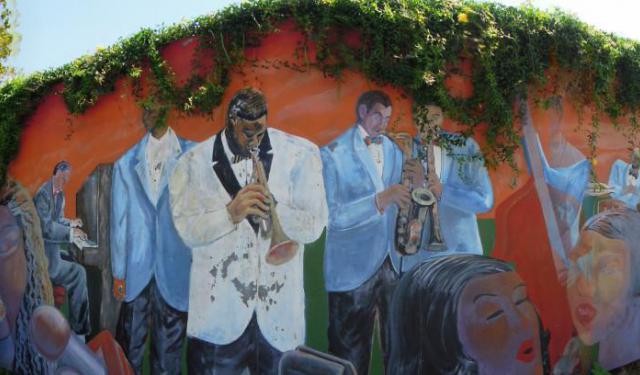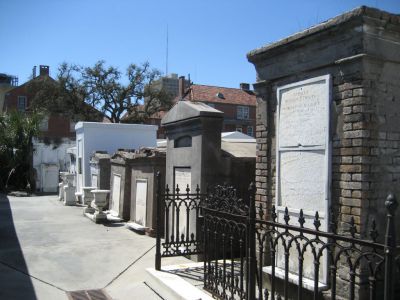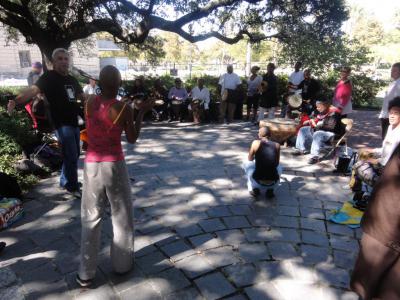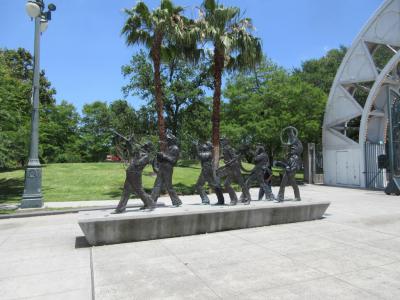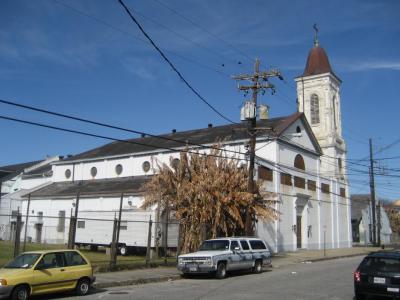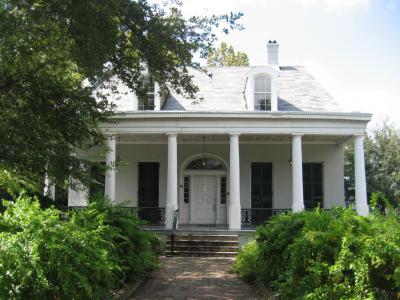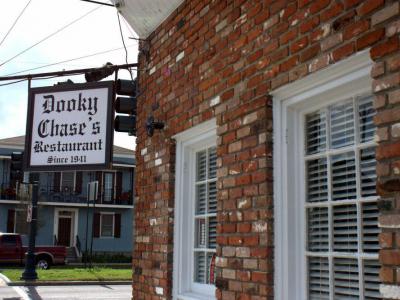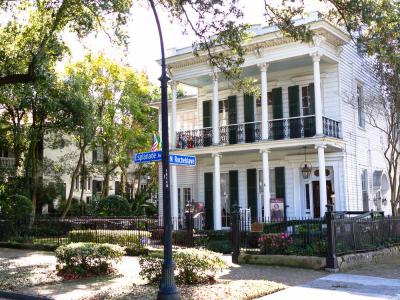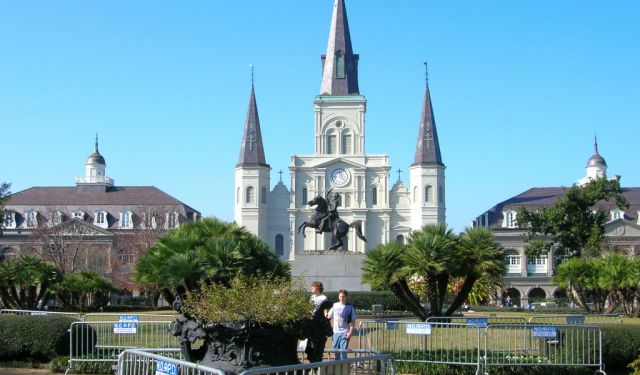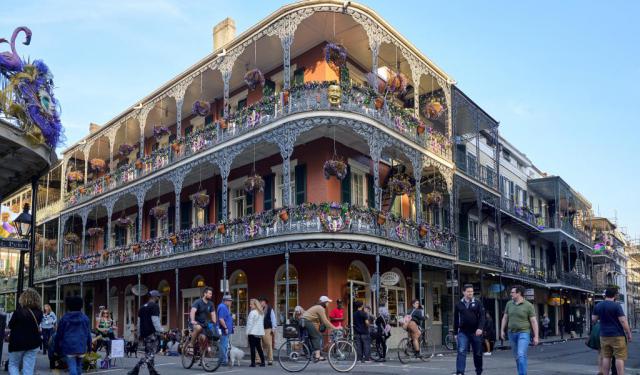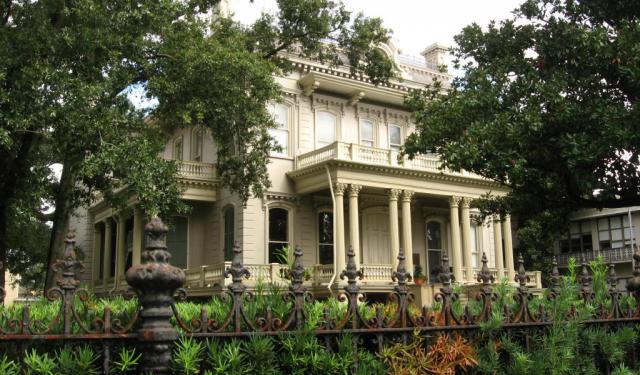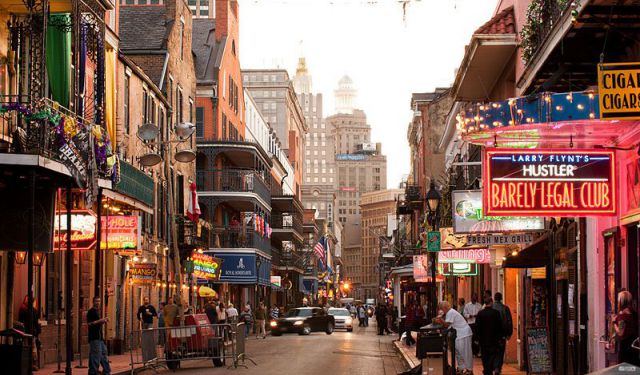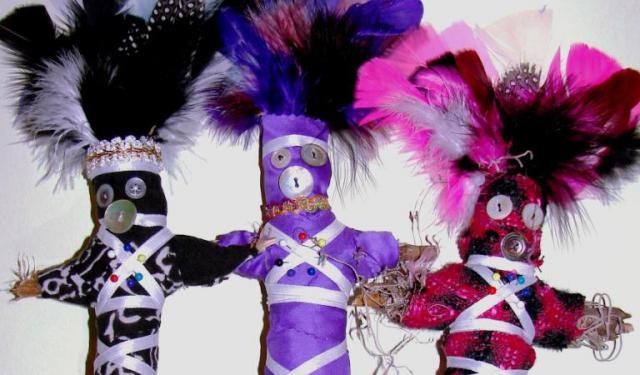African American Heritage Walking Tour (Self Guided), New Orleans
For over 300 years, the African-American community has played an intrinsic role in creating authentic New Orleans that everyone loves today. The bedrock of the city's life is built on the African-American experience, a heritage both proud and tragic, yet strong enough to have preserved throughout centuries the many aspects of African culture, influencing everything from religion to vibrant music to the spicy, singular food that New Orleanians eat for dinner.
Never segregated, the Saint Louis Cemetery No. 1 contains both white and African-American tombs, including that of Ernest “Dutch” Morial, the first African-American mayor of New Orleans (1978-86), who was instrumental in the building of the city’s very successful Convention Center. While there, you cannot continue further without walking through and enjoying the beautiful Congo Square. Full of history, beautiful art, and well-kept grounds, this place, along with adjacent Louis Armstrong Park, is a must-see.
The attractiveness of the African American Museum lies in the artwork that is used to depict the hardships and accomplishments of the Africans that did not come here of their own free will but still survived and flourished, continuing to do so till this day. The history of black slaves, the work of entrepreneurial black men and women in aiding slaves to freedom, along with eradicating poverty, hunger and homelessness, is further illustrated inside Free People of Color Museum – a well preserved 1850s mansion that ends your journey.
Take this tour of New Orleans to learn the history of African-Americans in the city and explore their traditions and culture!
Never segregated, the Saint Louis Cemetery No. 1 contains both white and African-American tombs, including that of Ernest “Dutch” Morial, the first African-American mayor of New Orleans (1978-86), who was instrumental in the building of the city’s very successful Convention Center. While there, you cannot continue further without walking through and enjoying the beautiful Congo Square. Full of history, beautiful art, and well-kept grounds, this place, along with adjacent Louis Armstrong Park, is a must-see.
The attractiveness of the African American Museum lies in the artwork that is used to depict the hardships and accomplishments of the Africans that did not come here of their own free will but still survived and flourished, continuing to do so till this day. The history of black slaves, the work of entrepreneurial black men and women in aiding slaves to freedom, along with eradicating poverty, hunger and homelessness, is further illustrated inside Free People of Color Museum – a well preserved 1850s mansion that ends your journey.
Take this tour of New Orleans to learn the history of African-Americans in the city and explore their traditions and culture!
How it works: Download the app "GPSmyCity: Walks in 1K+ Cities" from Apple App Store or Google Play Store to your mobile phone or tablet. The app turns your mobile device into a personal tour guide and its built-in GPS navigation functions guide you from one tour stop to next. The app works offline, so no data plan is needed when traveling abroad.
African American Heritage Walking Tour Map
Guide Name: African American Heritage Walking Tour
Guide Location: USA » New Orleans (See other walking tours in New Orleans)
Guide Type: Self-guided Walking Tour (Sightseeing)
# of Attractions: 7
Tour Duration: 2 Hour(s)
Travel Distance: 3.6 Km or 2.2 Miles
Author: DanaOffice
Sight(s) Featured in This Guide:
Guide Location: USA » New Orleans (See other walking tours in New Orleans)
Guide Type: Self-guided Walking Tour (Sightseeing)
# of Attractions: 7
Tour Duration: 2 Hour(s)
Travel Distance: 3.6 Km or 2.2 Miles
Author: DanaOffice
Sight(s) Featured in This Guide:
- St. Louis Cemetery No. 1
- Congo Square
- Louis Armstrong Park
- St. Augustine Catholic Church
- African American Museum
- Dooky Chase
- Free People of Color Museum
1) St. Louis Cemetery No. 1 (must see)
Quite possibly the oldest and most renowned among New Orleans' "cities of the dead", Saint Louis Cemetery Number One was established in 1789, following the devastating Great Fire of 1788, and was located just beyond the city's boundaries at the time. Due to the city's location below sea level and a high water table, the decision was made to bury bodies aboveground, as previous attempts at underground burials had resulted in caskets floating to the surface during floods.
Today, this cemetery houses more than 700 tombs and has been the final resting place for thousands of individuals. It features crypts designed by renowned architects and artists, creating a somewhat eerie labyrinth. Most of these aboveground structures are owned by families and designed to hold multiple sets of remains. While constructed primarily of brick, many of the elaborate tombs are often covered in concrete or stucco. Some of the oldest tombs have succumbed to time, reduced to little more than crumbling ruins and piles of brick dust. One intriguing feature is the segregated Protestant section, situated at the rear of the predominantly Catholic cemetery.
Among the famous residents are civil rights activist Homer Plessy (known for the landmark case Plessy v. Ferguson) and the beloved Voodoo priestess Marie Laveau. Her supposed tomb is a frequent stop on daily tours, although it's worth noting that she is believed to be actually buried in two separate tombs. Both graves bear the iconic XXX symbol, used to invoke Laveau's spirit for favors. Visitors often decorate them with Mardi Gras beads, bananas, flowers, bones, bottles of rum, and signed notes.
To enter the cemetery, tourists (those not related to the deceased) are required to be accompanied by a licensed tour guide, as mandated by the Archdiocese of New Orleans. Several organizations offer guided tours, with one of the most reputable being Save Our Cemeteries. They conduct hour-long excursions, with tours commencing from the lobby of Basin Street Station nearby.
Today, this cemetery houses more than 700 tombs and has been the final resting place for thousands of individuals. It features crypts designed by renowned architects and artists, creating a somewhat eerie labyrinth. Most of these aboveground structures are owned by families and designed to hold multiple sets of remains. While constructed primarily of brick, many of the elaborate tombs are often covered in concrete or stucco. Some of the oldest tombs have succumbed to time, reduced to little more than crumbling ruins and piles of brick dust. One intriguing feature is the segregated Protestant section, situated at the rear of the predominantly Catholic cemetery.
Among the famous residents are civil rights activist Homer Plessy (known for the landmark case Plessy v. Ferguson) and the beloved Voodoo priestess Marie Laveau. Her supposed tomb is a frequent stop on daily tours, although it's worth noting that she is believed to be actually buried in two separate tombs. Both graves bear the iconic XXX symbol, used to invoke Laveau's spirit for favors. Visitors often decorate them with Mardi Gras beads, bananas, flowers, bones, bottles of rum, and signed notes.
To enter the cemetery, tourists (those not related to the deceased) are required to be accompanied by a licensed tour guide, as mandated by the Archdiocese of New Orleans. Several organizations offer guided tours, with one of the most reputable being Save Our Cemeteries. They conduct hour-long excursions, with tours commencing from the lobby of Basin Street Station nearby.
2) Congo Square
The earliest Africans to arrive in Louisiana were brought as slaves in 1719 from the Senegambia region. Slavery was widely accepted in New Orleans, and over time, some Africans managed to obtain their freedom, becoming known as "free people of color". Many of these "freemen" were well-educated and were the descendants of black mothers and French or Spanish settlers.
In addition to culinary knowledge, African settlers brought their native music and spiritism in the form of the Voodoo religion. Congo Square, now part of Louis Armstrong Park near the French Quarter, served as a gathering place for both slaves and free people of color. This was particularly true on weekends when the Square transformed into a site for exotic tribal dances and celebrations.
The slave dances at Congo Square were a unique attraction for visitors to New Orleans. Herbert Asbury, in his book "The French Quarter", describes one such gathering: "The favorite dances of the slaves were the Calinda, a variation of which was also used in the Voodoo ceremonies, and the Dance of the Bamboula, both of which were primarily based on the primitive dances of the African jungle, but with copious borrowings from the contra-danses of the French . . . The male dancers attached tin or other metal to ribbons tied about their ankles. Thus accoutered, they pranced back and forth, leaping into the air and stamping in unison, occasionally shouting "Dansez Bomboula! Badoum! Badoum!", while the women, scarcely lifting their feet from the ground, swayed their bodies from side to side and chanted ancient song . . . The entire square was an almost solid mass of black bodies stamping and swaying to the rhythmic beat of the bones upon the cask, the frenzied, chanting of the women, and the clanging of the pieces of metal which dangled from the men's ankles."
The African instruments, such as drums and banjos, as well as the songs, eventually gave rise to street bands and, later, the development of jazz music. However, as the gatherings at Congo Square raised concerns among New Orleans citizens, who feared slave uprisings, they were restricted to Sunday daylight hours only in 1817.
Marie Laveau, often referred to as the first and most powerful "Voodoo Queen" of New Orleans, is one of the most well-known practitioners of Voodoo associated with Congo Square. In the 1830s, she not only led Voodoo dances but also organized more secretive rituals along the shores of Lake Pontchartrain and Saint John's Bayou.
In addition to culinary knowledge, African settlers brought their native music and spiritism in the form of the Voodoo religion. Congo Square, now part of Louis Armstrong Park near the French Quarter, served as a gathering place for both slaves and free people of color. This was particularly true on weekends when the Square transformed into a site for exotic tribal dances and celebrations.
The slave dances at Congo Square were a unique attraction for visitors to New Orleans. Herbert Asbury, in his book "The French Quarter", describes one such gathering: "The favorite dances of the slaves were the Calinda, a variation of which was also used in the Voodoo ceremonies, and the Dance of the Bamboula, both of which were primarily based on the primitive dances of the African jungle, but with copious borrowings from the contra-danses of the French . . . The male dancers attached tin or other metal to ribbons tied about their ankles. Thus accoutered, they pranced back and forth, leaping into the air and stamping in unison, occasionally shouting "Dansez Bomboula! Badoum! Badoum!", while the women, scarcely lifting their feet from the ground, swayed their bodies from side to side and chanted ancient song . . . The entire square was an almost solid mass of black bodies stamping and swaying to the rhythmic beat of the bones upon the cask, the frenzied, chanting of the women, and the clanging of the pieces of metal which dangled from the men's ankles."
The African instruments, such as drums and banjos, as well as the songs, eventually gave rise to street bands and, later, the development of jazz music. However, as the gatherings at Congo Square raised concerns among New Orleans citizens, who feared slave uprisings, they were restricted to Sunday daylight hours only in 1817.
Marie Laveau, often referred to as the first and most powerful "Voodoo Queen" of New Orleans, is one of the most well-known practitioners of Voodoo associated with Congo Square. In the 1830s, she not only led Voodoo dances but also organized more secretive rituals along the shores of Lake Pontchartrain and Saint John's Bayou.
3) Louis Armstrong Park
Located on the outskirts of the French Quarter, Armstrong Park not only honors one of its most celebrated native sons but also pays tribute to the numerous jazz musicians who have contributed to the rich musical traditions and cultural diversity that define New Orleans.
The park sits on the historic site once designated by Spanish-controlled city leaders in the late 18th century as the allowed gathering place for slaves on Sundays. Known as Congo Square, this area, along with the 31 enclosed park acres, holds a significant African heritage and borders the Tremé district, one of the earliest neighborhoods established by and for African Americans.
After the Civil War, white city leaders made efforts to suppress gatherings of freed slaves in the park and officially renamed it "Beauregard Square" in honor of Confederate General P. G. T. Beauregard. Despite these efforts, the park continued to be used for social gatherings and events, with the local community persistently referring to it as Congo Square. This enduring popularity eventually led to the creation of the New Orleans Jazz and Heritage Festival, initially drawing a modest audience but quickly expanding (after two years, it relocated to the larger New Orleans Fair Grounds racetrack). In 2001, the festival attracted approximately 650,000 attendees, and though attendance dipped following Hurricane Katrina, it rebounded to over 450,000 by 2014. In 2011, the New Orleans City Council officially restored the name Congo Square, and to honor its heritage, a "Congo Square Stage" remains a prominent feature at Jazz Fest.
Apart from hosting annual Martin Luther King Jr. Day celebrations, weddings, and various festivals, the park is often chosen as the location for movie premieres of films shot in New Orleans, as well as operas and Broadway productions like 'Lion King', 'Wicked', and 'Jersey Boys'. It is also home to the Mahalia Jackson Theater of the Performing Arts, which was extensively renovated after Hurricane Katrina and has become a vibrant hub for cultural events in the city. Surrounded by serene lagoons and graceful weeping willow trees, it provides a picturesque setting for patrons to enjoy intermissions by strolling and appreciating the park's natural beauty.
Plan a leisurely afternoon to explore Louis Armstrong Park and the surrounding neighborhood, , indulging in walks, dining, sunbathing, and soaking in the historical significance that permeates every corner. It's a reminder that New Orleans is much more than just Bourbon Street and beignets, offering a rich cultural tapestry waiting to be discovered.
The park sits on the historic site once designated by Spanish-controlled city leaders in the late 18th century as the allowed gathering place for slaves on Sundays. Known as Congo Square, this area, along with the 31 enclosed park acres, holds a significant African heritage and borders the Tremé district, one of the earliest neighborhoods established by and for African Americans.
After the Civil War, white city leaders made efforts to suppress gatherings of freed slaves in the park and officially renamed it "Beauregard Square" in honor of Confederate General P. G. T. Beauregard. Despite these efforts, the park continued to be used for social gatherings and events, with the local community persistently referring to it as Congo Square. This enduring popularity eventually led to the creation of the New Orleans Jazz and Heritage Festival, initially drawing a modest audience but quickly expanding (after two years, it relocated to the larger New Orleans Fair Grounds racetrack). In 2001, the festival attracted approximately 650,000 attendees, and though attendance dipped following Hurricane Katrina, it rebounded to over 450,000 by 2014. In 2011, the New Orleans City Council officially restored the name Congo Square, and to honor its heritage, a "Congo Square Stage" remains a prominent feature at Jazz Fest.
Apart from hosting annual Martin Luther King Jr. Day celebrations, weddings, and various festivals, the park is often chosen as the location for movie premieres of films shot in New Orleans, as well as operas and Broadway productions like 'Lion King', 'Wicked', and 'Jersey Boys'. It is also home to the Mahalia Jackson Theater of the Performing Arts, which was extensively renovated after Hurricane Katrina and has become a vibrant hub for cultural events in the city. Surrounded by serene lagoons and graceful weeping willow trees, it provides a picturesque setting for patrons to enjoy intermissions by strolling and appreciating the park's natural beauty.
Plan a leisurely afternoon to explore Louis Armstrong Park and the surrounding neighborhood, , indulging in walks, dining, sunbathing, and soaking in the historical significance that permeates every corner. It's a reminder that New Orleans is much more than just Bourbon Street and beignets, offering a rich cultural tapestry waiting to be discovered.
4) St. Augustine Catholic Church
Saint Augustine, the oldest African-American Catholic parish in the United States, stands on Saint Claude Avenue near the French Quarter, occupying the former Claude Tremé plantation site. Established in 1841, its history is closely intertwined with the community, including immigrants, slaves, and free people of color who played a pivotal role in its construction.
The church's architectural significance includes its design by J. N. B. de Pouilly, the same French architect renowned for his work on the nearby Saint Louis Cathedral. Notably, the pew arrangements reveal a fascinating history. In the past, pew fees were charged to parishioners seeking designated seating privileges, generating income for church operations. Free people of color purchased pews for their families and extended their generosity to less fortunate faithful, including slaves who couldn't afford seating. This led to the "War of the Pews", ultimately won by free people of color, resulting in the most integrated congregational church seating in the country.
Renowned for its inspirational music, Saint Augustine welcomes visitors of all faiths to its services, and also hosts the annual Jazz Mass as part of the Satchmo Summer Jazz Festival, paying tribute to Louis Armstrong. Exploring independently or joining a guided tour allows you to delve into its history, including the Tomb of the Unknown Slave, a poignant shrine honoring all enslaved individuals buried in Tremé.
Despite the threat of closure post-Hurricane Katrina, the determination of Saint Augustine Church's parishioners, along with grants and community support, ensured the preservation of this invaluable piece of living history.
The church's architectural significance includes its design by J. N. B. de Pouilly, the same French architect renowned for his work on the nearby Saint Louis Cathedral. Notably, the pew arrangements reveal a fascinating history. In the past, pew fees were charged to parishioners seeking designated seating privileges, generating income for church operations. Free people of color purchased pews for their families and extended their generosity to less fortunate faithful, including slaves who couldn't afford seating. This led to the "War of the Pews", ultimately won by free people of color, resulting in the most integrated congregational church seating in the country.
Renowned for its inspirational music, Saint Augustine welcomes visitors of all faiths to its services, and also hosts the annual Jazz Mass as part of the Satchmo Summer Jazz Festival, paying tribute to Louis Armstrong. Exploring independently or joining a guided tour allows you to delve into its history, including the Tomb of the Unknown Slave, a poignant shrine honoring all enslaved individuals buried in Tremé.
Despite the threat of closure post-Hurricane Katrina, the determination of Saint Augustine Church's parishioners, along with grants and community support, ensured the preservation of this invaluable piece of living history.
5) African American Museum
Located in Tremé, the oldest African-American community in the United States, this museum finds its home within an exquisite Creole villa dating back to 1828. The architectural style reflects influences from the West Indies and French colonial traditions, featuring three courtyards and a central gazebo that provide an enjoyable experience for all visitors.
Within the museum, ever-changing exhibits offer a comprehensive exploration of African American art, history, and culture in New Orleans and the broader diaspora. Engaging videos, captivating artifacts, and informative text panels converge to create a compelling, thought-provoking, and uplifting portrayal of this resilient community. A notable highlight, the Betrand Collection, showcases an array of jewelry, clothing, masks, artifacts, and musical instruments from the Democratic Republic of Congo. This exhibit illuminates fascinating parallels between African and African American cultures, offering a unique perspective.
Overall, the museum provides an ambitious and refreshing perspective, offering valuable insights that complement the often overlooked discussions of slavery and its enduring impact. If you find yourself with some spare time, be sure to pay a visit!
Within the museum, ever-changing exhibits offer a comprehensive exploration of African American art, history, and culture in New Orleans and the broader diaspora. Engaging videos, captivating artifacts, and informative text panels converge to create a compelling, thought-provoking, and uplifting portrayal of this resilient community. A notable highlight, the Betrand Collection, showcases an array of jewelry, clothing, masks, artifacts, and musical instruments from the Democratic Republic of Congo. This exhibit illuminates fascinating parallels between African and African American cultures, offering a unique perspective.
Overall, the museum provides an ambitious and refreshing perspective, offering valuable insights that complement the often overlooked discussions of slavery and its enduring impact. If you find yourself with some spare time, be sure to pay a visit!
6) Dooky Chase
Dooky Chase holds an esteemed place in Tremé, known as the most renowned and culturally significant restaurant in the neighborhood. Chef Leah Chase, affectionately known as "the Queen of Creole Cuisine", dedicated seven decades of her life to this establishment until her passing in 2019. Throughout its history, Dooky Chase welcomed a diverse array of patrons, including locals, civil rights activists, politicians, and even U.S. presidents. It has gained recognition as a beloved spot to savor dishes like red beans and rice, crispy-fried chicken, peach cobbler, and Shrimp Clemenceau, a dish that was previously exclusive to whites-only eateries. In 2018, Food & Wine magazine acknowledged this restaurant as one of the 40 most influential dining establishments of the past four decades.
Beyond her culinary talents, Leah Chase hosted art gallery openings for emerging artists during the Civil Rights era and amassed an impressive collection of African-American artwork, which you are encouraged to admire. Her restaurant showcased numerous paintings and sculptures by acclaimed artists like Elizabeth Catlett and John T. Biggers, and she regularly featured local musicians in the bar area.
During the 1950s and 1960s, Dooky Chase served as a hub for Civil Rights activism, where progressive thinkers secretly gathered in the upstairs dining room to strategize nonviolent resistance against segregation. Prominent figures such as Rev. Martin Luther King Sr., who favored barbecued ribs, and James Baldwin, a fan of gumbo, frequented the establishment. Renowned singer Sarah Vaughan ordered stuffed crab to go, while Nat King Cole had a penchant for four-minute eggs. Notably, in early 2008, then-future President Barack Obama narrowly avoided a culinary faux pas when he attempted to add hot sauce to his gumbo but was tactfully dissuaded by the owner. Even amidst lingering tensions from Hurricane Katrina, Leah Chase graciously served President George W. Bush crab soup and Shrimp Clemenceau on the second anniversary of the devastating storm, a testament to her enduring hospitality.
Beyond her culinary talents, Leah Chase hosted art gallery openings for emerging artists during the Civil Rights era and amassed an impressive collection of African-American artwork, which you are encouraged to admire. Her restaurant showcased numerous paintings and sculptures by acclaimed artists like Elizabeth Catlett and John T. Biggers, and she regularly featured local musicians in the bar area.
During the 1950s and 1960s, Dooky Chase served as a hub for Civil Rights activism, where progressive thinkers secretly gathered in the upstairs dining room to strategize nonviolent resistance against segregation. Prominent figures such as Rev. Martin Luther King Sr., who favored barbecued ribs, and James Baldwin, a fan of gumbo, frequented the establishment. Renowned singer Sarah Vaughan ordered stuffed crab to go, while Nat King Cole had a penchant for four-minute eggs. Notably, in early 2008, then-future President Barack Obama narrowly avoided a culinary faux pas when he attempted to add hot sauce to his gumbo but was tactfully dissuaded by the owner. Even amidst lingering tensions from Hurricane Katrina, Leah Chase graciously served President George W. Bush crab soup and Shrimp Clemenceau on the second anniversary of the devastating storm, a testament to her enduring hospitality.
7) Free People of Color Museum
Housed within an elegant 1859 Greek Revival mansion in the Upper Tremé, this museum is a testament to a 30-year compilation of artifacts, documents, furniture, and art. Its mission is to illuminate the often-overlooked history of a remarkable subculture: the 'free people of color' who played a distinctive yet significant role in shaping the city before the Civil War. To explore this captivating narrative, visitors must arrange guided tours in advance.
Each room within the museum offers a glimpse into various epochs of the city's history, with a special focus on the life of Dr. Louis Charles Roudanez, a physician and newspaper publisher born in 1823. The collection, though modest in size, is nothing short of fascinating, including original records that detail the journeys of those who transitioned from slavery to freedom, achieved either through 'coartación' (purchasing their own freedom) or as recognition for exceptional service. Additionally, the house and the grounds are neatly maintained.
Each room within the museum offers a glimpse into various epochs of the city's history, with a special focus on the life of Dr. Louis Charles Roudanez, a physician and newspaper publisher born in 1823. The collection, though modest in size, is nothing short of fascinating, including original records that detail the journeys of those who transitioned from slavery to freedom, achieved either through 'coartación' (purchasing their own freedom) or as recognition for exceptional service. Additionally, the house and the grounds are neatly maintained.
Walking Tours in New Orleans, Louisiana
Create Your Own Walk in New Orleans
Creating your own self-guided walk in New Orleans is easy and fun. Choose the city attractions that you want to see and a walk route map will be created just for you. You can even set your hotel as the start point of the walk.
Top Religious Sites Walking Tour
New Orleans has some of the oldest and most beautiful churches in Louisiana. Some of them, like the St. Louis Cathedral, have become iconic symbols of the city, while others are considered to provide "fresh air" to the busy business quarters.
The churches on this walking tour combine different architectural styles, starting with the Spanish Colonial & French Neo-Gothic design of... view more
Tour Duration: 2 Hour(s)
Travel Distance: 4.0 Km or 2.5 Miles
The churches on this walking tour combine different architectural styles, starting with the Spanish Colonial & French Neo-Gothic design of... view more
Tour Duration: 2 Hour(s)
Travel Distance: 4.0 Km or 2.5 Miles
French Quarter Historical Buildings Walking Tour
Widely known for its heritage sites with a variety of unique architectural styles, New Orleans has lots of beautiful buildings designed in the Greek Revival, American Colonial, or Victorian styles. Walking around the French Quarter, you'll enjoy these old historic buildings (some open to the public), their old ironwork gates and balcony railings, the antique brick- and stone-paved sidewalks... view more
Tour Duration: 2 Hour(s)
Travel Distance: 2.3 Km or 1.4 Miles
Tour Duration: 2 Hour(s)
Travel Distance: 2.3 Km or 1.4 Miles
Garden District Walking Tour
It may come as a surprise, but New Orleans’ Garden District is known for its architecture more than for its gardens. The city’s elite residential neighborhood since the 19th century, when wealthy newcomers built opulent structures, it is considered one of the best-preserved collections of historic mansions in the South, and certainly one of the most picturesque. You can see why this is the... view more
Tour Duration: 1 Hour(s)
Travel Distance: 1.9 Km or 1.2 Miles
Tour Duration: 1 Hour(s)
Travel Distance: 1.9 Km or 1.2 Miles
French Quarter Walking Tour
The French Quarter, also known as the Old Square, is New Orleans' oldest and most popular neighborhood. Founded in 1718, it perfectly combines the tempting, noisy and nutty nightlife of Bourbon Street with important historical landmarks, art galleries, sophisticated cafés, and some of the city's oldest churches – all within walking distance, close to Mississippi River.
On this... view more
Tour Duration: 2 Hour(s)
Travel Distance: 3.4 Km or 2.1 Miles
On this... view more
Tour Duration: 2 Hour(s)
Travel Distance: 3.4 Km or 2.1 Miles
Voodoo Tour
Voodoo is an ancient ritualistic practice brought by enslaved West Africans onto the American soil upon their arrival in the 18th century. This form of religion was most prominent in New Orleans from the 1820s through the 1860s, when it was introduced by the “Voodoo Queens”. Of these, Marie Laveau became more prominent as she overthrew other queens to become the sole oracle.
Your best... view more
Tour Duration: 1 Hour(s)
Travel Distance: 2.6 Km or 1.6 Miles
Your best... view more
Tour Duration: 1 Hour(s)
Travel Distance: 2.6 Km or 1.6 Miles
The Most Popular Cities
/ view all
